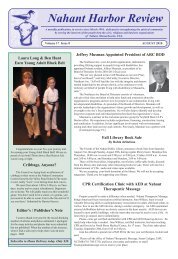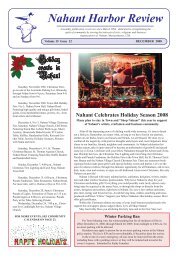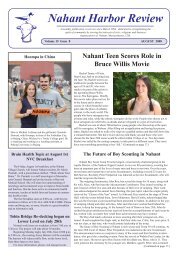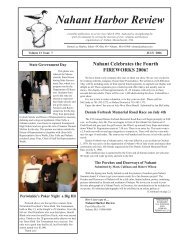Nahant Harbor Review - Nahant, Massachusetts USA
Nahant Harbor Review - Nahant, Massachusetts USA
Nahant Harbor Review - Nahant, Massachusetts USA
You also want an ePaper? Increase the reach of your titles
YUMPU automatically turns print PDFs into web optimized ePapers that Google loves.
NAHANT HARBOR REVIEW • MAY 2006 • Page 14<strong>Nahant</strong> Rocks!By Daniel A. deStefanoAt <strong>Nahant</strong>’s Annual Town Meeting, certain speakers may be accusedby their listeners of filling their mouths with pebbles, having anadamantine attitude, or even of having rocks in their heads! Some residentseven refer to <strong>Nahant</strong> as “The Rock.” But a truly inquiring minddemands: “Where did all this hard stuff come from?”It was a <strong>Nahant</strong> resident who first described the island’s rocks:Louis Agassiz, who lived on <strong>Nahant</strong> during the 1850s. Agassiz, a Swissnaturalist, came to teach at Harvard University, at the urging of hisfriend, poet Henry Longfellow. Agassiz’s first visit to the United Statesincluded a stay at the Longfellows’ home in <strong>Nahant</strong>. Agassiz fell in lovewith the beauty of the island and bought a house here. The Swiss scientistfound that the exposed slabs of <strong>Nahant</strong>’s rocks tell a fascinating storyof the past.What did Louis Agassiz discover?Picture a quiet sea. Warm and filled with life, the sea bottom iscoated by a mantle of shells from snails and other small creatures, depositedwhen the animals died. Eventually, this litter builds into a thicklayer. Other sediments, composed of silt, pebbles and plants, also descendto the depths, year following year, layer upon layer. Newer layerscrush those beneath. Millions of years of compression causes the materialsburied under the sea bed to fuse into a type of stone called “sedimentary.”At <strong>Nahant</strong>, Agassiz saw that fused shells had formed white to graybeds of limestone, that generally lay under gray, black, or green beds ofsilt, that had formed shale. These are the oldest rocks of <strong>Nahant</strong>. Limestoneand shale of this type are found at East Point, a few sites along thenortherly shore of Little <strong>Nahant</strong> and near Maolis Spring.Sedimentary rocks, similar to those of <strong>Nahant</strong>, lie exposed atAttleboro, Quincy, and Weymouth, and it is from the last town thatgeologists have named these rocks: the Weymouth Formation, whichdates from the early Cambrian Era, 600 million years ago. Parts of theWeymouth Formation, which originated as beds of the Cambrian Sea,have been found also in North and South America, West Africa andEurope.These ancient rocks hold fossil shells, found at East Point, belowthe lip of the cliff, and represent the oldest rocks known to containabundant fossils. Earlier forms of life lack shells, or other hard parts, andhave been preserved only rarely. In the fossil beds of East Point havebeen identified two species of lamp shells (brachiopods) and nine speciesof snails (gastropods), only one of which was coiled.These animals lived and died in the Cambrian sea, their shellsburied in the beds of slimy mud. Hundreds of millions of years later,crustal movement bent the beds into great folds. The tremendous heatand pressure of this activity partly recrystallized the beds into whitemarble and dark hornfels, a process geologists call “metamorphosis.”Most of the <strong>Nahant</strong> island group, including Egg Rock, is made up ofrock younger than those of the Weymouth Formation, called “gabbro.”Gabbro is an igneous rock, formed when a large mass of melted rock,called “magma,” cools and crystallizes deep within the earth.Our local gabbro is marked by bands and speckles, indicating thatthe magma underwent considerable movement as it cooled.Magma is less dense than the cool rock from which it melted and sotends to rise to the surface. When magma breaks the surface, we call it“lava,” and the event itself is termed a “volcanic eruption.”Sometimes, magma freezes inside the earth, forming an “intrusion”into pre-existing rock. When rising magma penetrates layers of horizontalsedimentary rock, the liquid rock will force a path of least resistanceand squeeze into fractures horizontally, as well as vertically. This is a socalled“Christmas Tree” pattern.Magma that freezes vertically is called a “dike,” while that solidifiedin a horizontal orientation is termed a “sill.” East Point boasts morethan 100 dikes. So many intrusions were accompanied by the tremendousheat of the gabbroic magma, which cooked the older rock of theWeymouth Formation, recrystallizing it into a stony stew of minerals:white sugar marble, tough hornfels, bubbles (or knots) of dark greenchlorite and pistaschio-green epidote.At the same time, water, heated by the magma, steamed the stone,resulting in the formation of red-brown rust, green serpentine, epidoteand chlorite, white calcite and quartz. Erosion at East Point has exposedall of these on the seaward cliffs and at Bass Rocks and Little <strong>Nahant</strong>.Within historic times, <strong>Nahant</strong> was mined as a source of iron ore.Iron was first worked at the Saugus Iron Works in 1643. The coloniststook some of their iron ore from the black rocks near the northeasternend of Summer Street, which was called Black Mine, or the Iron Mine.Forty Steps Beach was mined for a mineral named “flux,” used to processthe iron.The complex igneous history of <strong>Nahant</strong> shows its final stage betweenBlack Mine and Spouting Horn. Here, pinkish dikes intrude intothe <strong>Nahant</strong> Gabbro. Similar events occurred at Beverly, Marblehead,Peabody and Quincy, so the newer pink rock is named “Beverly syenite.”Heat and solutions from this very large magmatic mass changed the<strong>Nahant</strong> Gabbro into granite. <strong>Nahant</strong>’s north shore marks the edge of thisreaction zone.The <strong>Nahant</strong> Gabbro intruded into the Weymouth Formation duringthe Ordovician Period, 438 to 505 million years ago. When the pinkgranite dikes squeezed into the gabbro is not so precisely known.About 200 million years ago, near the end of the Permian Period,much of eastern New England experienced a period of faulting andfolding. This created newer fractures that crosscut the <strong>Nahant</strong> Gabbro.Water flowing through these young fractures, while the rock was stillburied, deposited calcite, quartz and epidote.<strong>Nahant</strong> was probably raised from the depths at this time, as fourblocks separated from the mainland by the North Border Fault of theBoston Basin. Three faults, or fractures in the earth’s crust, divide<strong>Nahant</strong> into four sections, which represent the edges of each block andmay once have been separate islands.Walk across the rocks at Forty Steps Beach to see examples offractured and offset dikes. Folded sheeting joints, which are parallelcracks in rocks near the earth’s surface, are visible at the southeasternside of that beach.Possibly, all this folding and faulting, occurred as part of theAlleghenian Orogeny, an event that built mountains, or during the openingof the Atlantic Ocean. The Alleghenian Orogeny took place duringthe early Permian Period (280 million years ago), and the Atlantic Oceanbegan to open in the Triassic Period (200 million years ago).Can you picture 900 feet of ice pressing on the spot where you nowsit? That was the thickness of the sheet of ice over the Boston area,during the last ice age, about 15,000 years ago.Glaciers advanced four times, during the past million years. Eachtime, sheets of ice scraped the land, eroding, as they moved, any softrock beneath. The stubborn <strong>Nahant</strong> gabbro resisted this icy scouring. Thegabbro hills of Big and Little <strong>Nahant</strong> stand as mute witnesses to all therest that the glaciers rubbed away.Advancing glaciers bear vast amounts of sediments, varying fromtiny grains of clay to gigantic boulders. A glacier may deposit this sedimentat its leading edge, or leave it behind, when the glacier melts. Sucha mass of clay, sand, cobble, gravel and boulders taken together aretermed “till.” Most of the sand and stones that make up <strong>Nahant</strong>’s beachesare glacial till.<strong>Nahant</strong> has two tombolos, sand bars that flood at high tide, onebeneath the manmade causeway and the other between Greater andLesser <strong>Nahant</strong>. These were built by the action of waves that strike againstthe gabbro blocks. These waves deposit any sand that they carry on thelee side of each island.So, as you listen to the orators at Town Meeting this year, recall thestubborness of gabbro and the vast power of scraping ice and wonder no
















